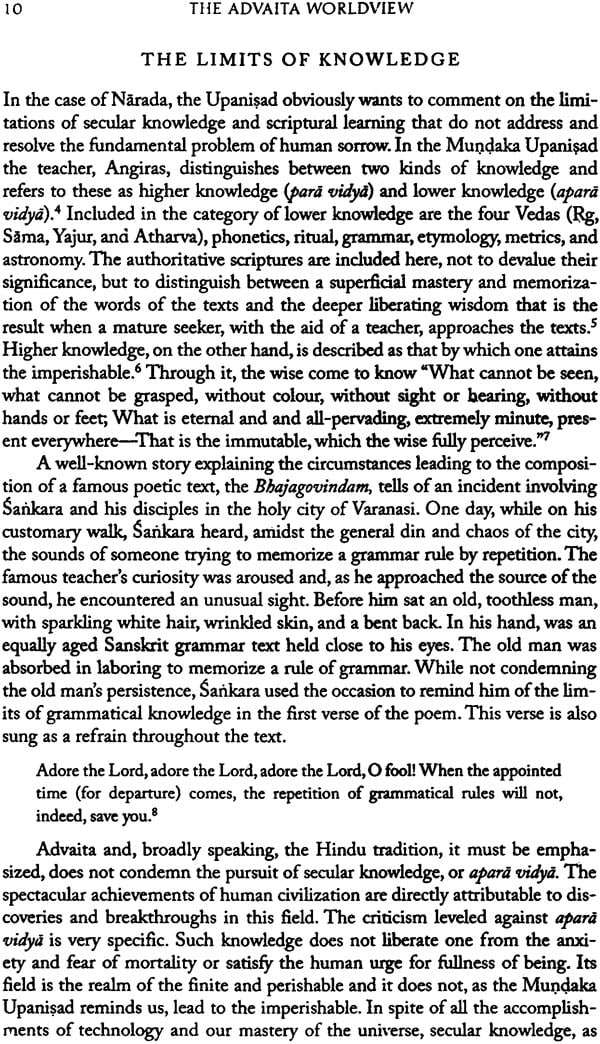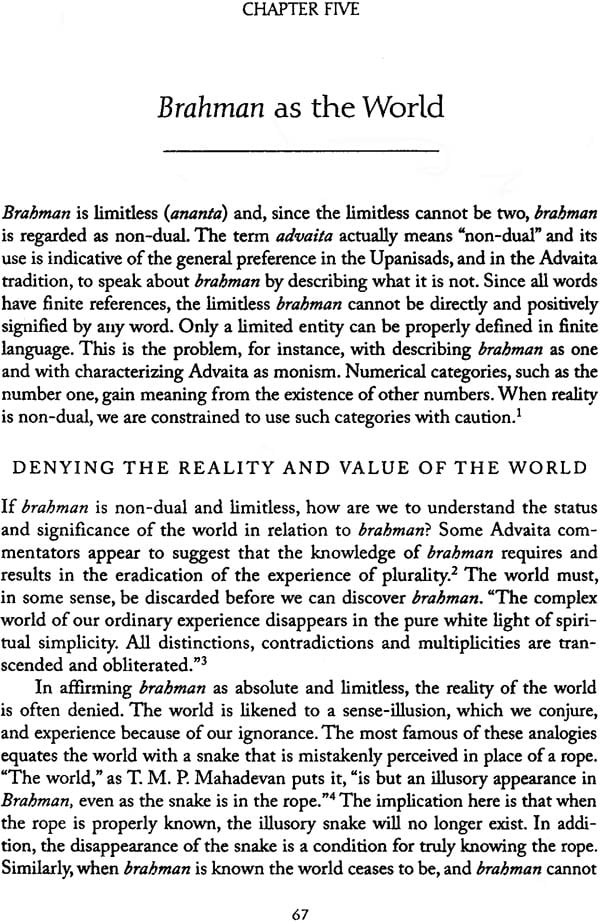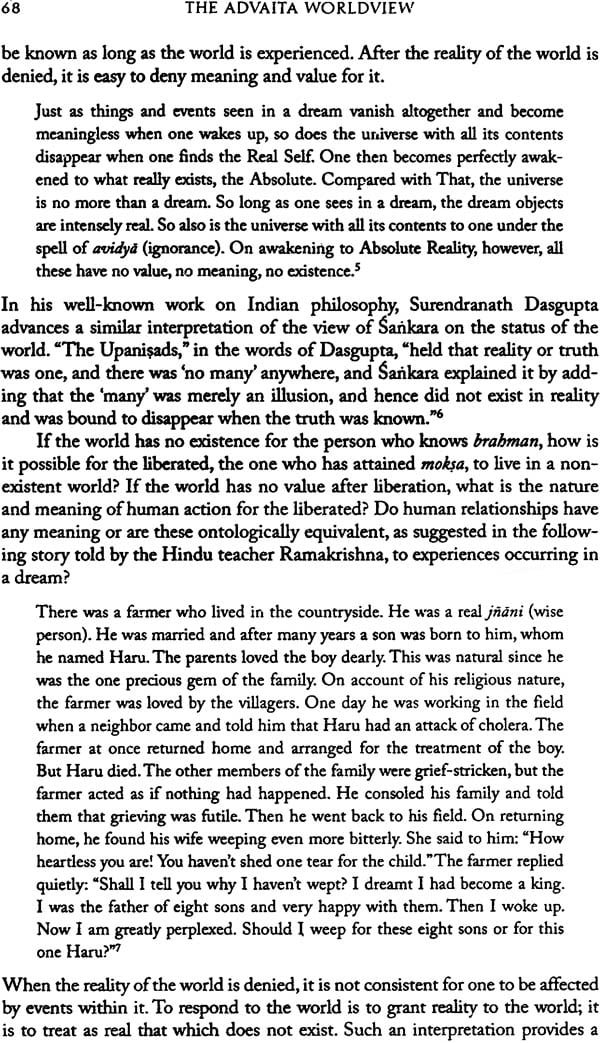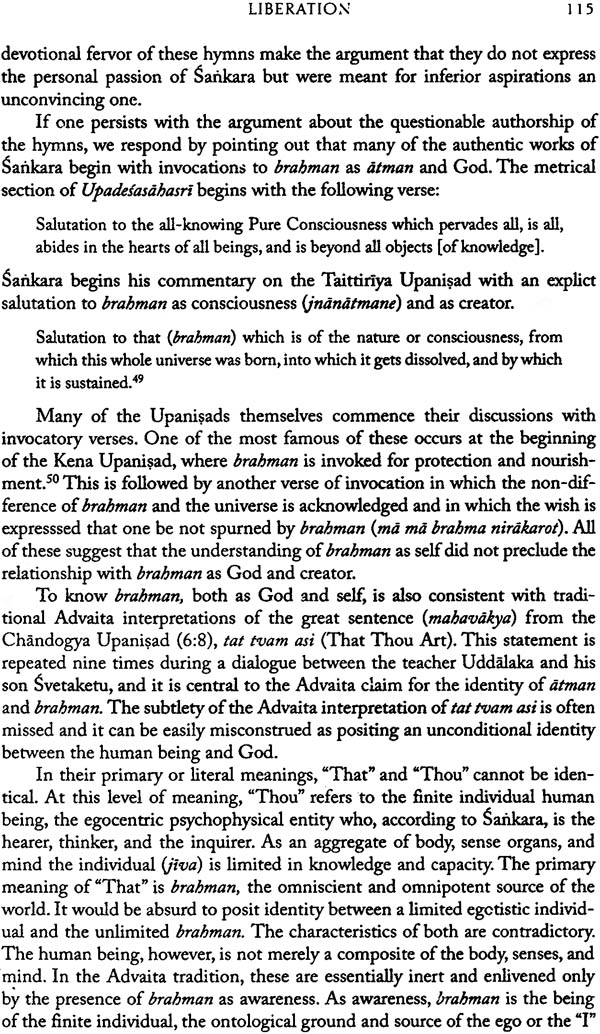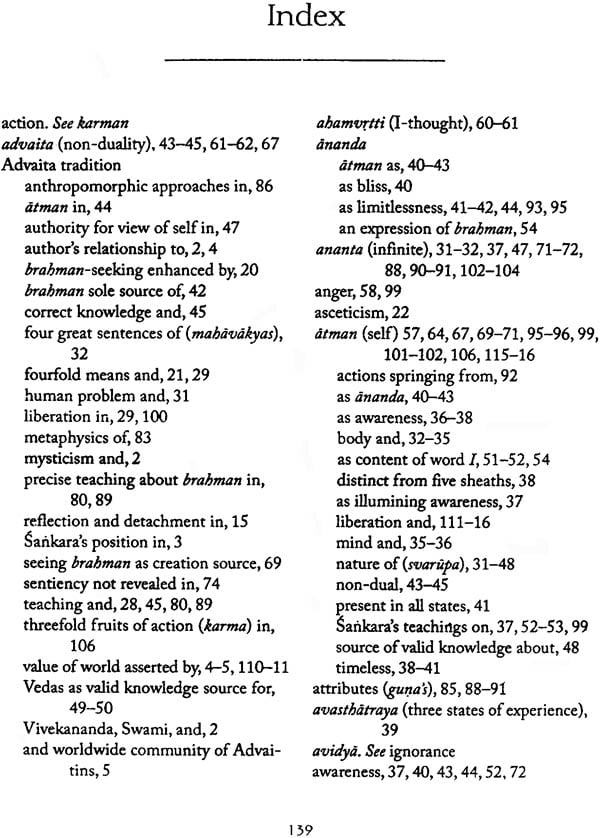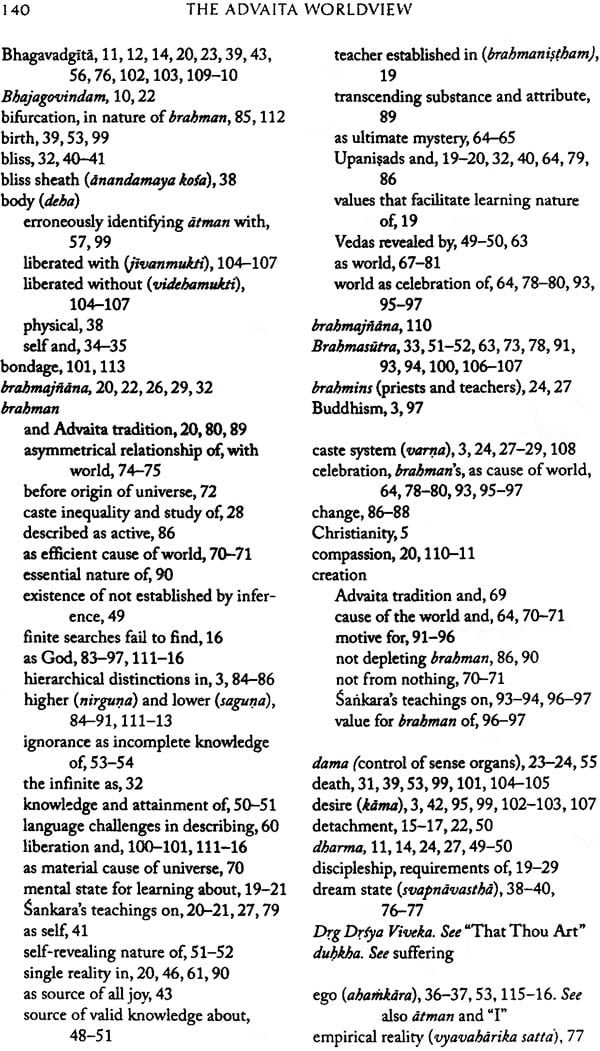
The Advaita Worldview (God, World, and Humanity)
Book Specification
| Item Code: | NAL990 |
| Author: | Anantanand Rambachan |
| Publisher: | Divine Books |
| Language: | English |
| Edition: | 2012 |
| ISBN: | 9789381218617 |
| Pages: | 258 |
| Cover: | Hardcover |
| Other Details | 8.5 inch X 5.5 inch |
| Weight | 200 gm |
Book Description
In the book, Anantanand rambachan offers a fresh and detailed perspective on Advaita Vedanta. Hinduism’s most influential and revered religious tradition. Rambachan, who is both scholar and an Advaitin, attends closely to the Upanisads and authentic commentaries of Sankara to challenge the tradition and to reconsider central aspects of its current teachings. His reconstruction and reinterpretation of Advaita focuses in particular on the nature of Brahman, the status of the world in relation to Brahman, and the meaning and relevance of liberation.
Rambachan queries contemporary representations of an impersonal Brahman and the need for popular, hierarchical such as those between a higher (para) and lower (apara) brahman, Such distinctions. Rambachan argues, are inconsistent with the non-dual of Brahman and are unnecessary when brahman’s relationship with the world is correctly understood. Questioning Advaita’s traditional emphasis on renunciation and world-denial. Rambachan expands the understanding of suffering (duhkha) and liberation (moksa) and address socioeconomic as well as gender and caste inequalities. Positing that the world is a celebrative expression of God’s fullness, this book advances Advaita as a uninhibited parth to a liberated life committed to compassion, equality, and justice.
“This is a fine introduction to, and argument for a reinterpretation of, Asdait Vedanta by a scholar who is also an Advaitin. The book is thus constructive in two senses, it is theological and largely positive, while still solid scholarship. Such a combination, especially done well, is rare.” – Andrew Q Fort, author of Jivanmukti Transformation: Embodied Liberation in Advaita and Neo- Vedaita
“The book embraces a fresh alternative to mainstream Advaita illusionism. Because of its novel understanding of the place and value of non-dualistic spirituality for contemporary societal, needs its plentiful illustrative examples, its practical spiritual guidance. Its clear style, and overall brevity, it should be appreciated by both novice and the trained scholar” – Bradley J Malkovsky, editor of New perspectives on Advita Vedanta
On the basis of a well-known principle of classification, the indigenous religious systems of India are divided into two broad categories: astika (orthodox) and nastika (heterodox). The criterion of orthodoxy is the acceptance of the Vedas as an authoritative source of knowledge. Among the systems that are regarded as orthodox, the Advaita tradition has perhaps exerted the most widespread influence. Adcaita, in the words of Eliot Deutsch, “had been and continues to be, the most widely accepted system of thought philosophers in India, and it is, we believe, one of the greatest philosophical achievements to be found in the East or in world. The foremost systematizer and exponent of Advaita is Sankara, who interprets the Vedas, and especially the Upanisads, as affirming an ultimate ontological non-duality.
The Advaita tradition had been the principal focus of my scholarly research and publication. In my first study on Advaita, I undertook a refutation of contemporary interpretations of the epistemology of Sankara. Sankara is widely represented in these studies as having accorded only a provisional validity to knowledge gained by inquiry into the words of the Vedas. According to this popular view, Sankara did not see the Vedas as the unique and definitive source for the knowledge of Brahman, but proposed personal experience ((anubhava) as superior to the Vedas. The affirmations of the Vedas need to be verified by secondary authority.
In Accomplishing the Accomplished, I argue that such interpretations misrepresent Sankara’s epistemology in failing to apprehend the meaning that he ascribes to the Vedas as the definitive means of knowing Brahman. In relation to the knowledge of Brahman, Sankara saw all other source as subordinate to the Vedas and supported his view with detailed arguments. I presented Sankara’s argument s as centered on three interred claims: (1) the Vedas as a logical means of knowledge, (2) Vedas as an adequate means of knowledge, and (3) the Vedas as a fruitful means of knowledge.
In my second Advaita work, The Limits of Scipture: Vivekanandas’ Reinterpretation of the Vedas, I undertook an exposition and critique of Swami Vivekananda’s interpretation of the relationship and personal experience. Vivekananda is one of the most influential interpreters in the recent history of Hinduism. He champions the argument that authoritative means of knowledge, in Advaita, is a special experience that reveals, beyond doubt, the truths of the universe and human existence. The teachings of the Vedas, according to Vivekananda, possess only hypothetical or provisional validity and need the verification that personal experience provides. He subordinates the scripture to experience. It is clear that the aforementioned interpretation of Sankara’s epistemology is deeply influenced by Vivekananada’s formulation and presentation of Advaita.
In Limits of Scripture, I challenge the common identification of Vivekananda’s interpretations with those of Sankara and discuss significant divergences between both commentators. I assess the consistency and persuasiveness of his arguments, within the Advaita framework, for personal experience as superior to scripture, and offer a historical explanation for the increasing characterization of Advaita as mystical, and the secondary role attribute scripture.
Some of the reviewers of my books expressed the need for me to construct my own position on the process of attaining liberating knowledge in Advaita. This was a fair challenge. Since my publications on Sankara and Vivekananda were concerned primarily with clarifying and assessing their interpretations, these did not offer the scope for reconstruction. The present work is my attempt to respond to this invitation and to, my desire to reconsider central facts of the Advaita worldview. The interpretations of the Advaita tradition that I offer, however, are not limited to explicating the relationship between scripture and personal experience. I extend the discussion to include, among other core issues, matters such as the nature of God-world relationship, and the meaning of liberation.
Theological reconstruction is a process and interpretation and there are at two ways in which this will be evident in my analysis. One of the very important movements in recent Advaita scholarship is the effort to develop a more critical approach to the tradition and to distinguish the exposition of Sankara from later exegetes. For too long, the views of Sankara have been uncritically equated with those of his successors. This task involves the effort both to establish the authentic woks of Sankara, and to extricate his interpretations from those advanced by subsequent Advaitins. It will be evident, at aious points in my discussion, that I continue this critical process.
Advaita scholarship and reflection, however, cannot limit itself to the clarification and exposition of Sankara’s understanding. His interpretations and assumptions must also be subject to the critical process in order for the tradition to be relevant and creative. It is wrong for persons committed to Advaita to assume that Sankara was not susceptible to the historical influences of his time, the presuppositions of his context, and his stage in life as a renunciant. The traditional reverence for Sankara, and the deified position that he occupies in the Advaita lineage, ought not inhibit the kinds of questions that are addressed to his commentarial legacy. His monumental contribution can be gratefully appraised within the tradition.
The reader will discern this interpretative process at the many places in this work where I question Sankara’s reading of Upanisad texts or the inferences that he draws from these. The limits of history and context are evident, not only in the ways in which a particular text is read, also in the ignored implications of texts and in the selection and overlooking of texts. Limits are also apparent in the issues that engage attention, in the kinds of questions asked, and in those that remain unasked. Let me illustrate this with a few examples. Sankara confined eligibility for Vedic study to male, members of the first three castes and approvingly cities traditional sources that prescribe cruel punishment for the violation of this exclusion. This is a matter that has received scant attention from Advaitins, and caste considerations continue to be significant in institutions supposedly by or associated with Sankara. What is the significance of caste division in a tradition that proclaims the identity and sameness of the self in all being? Should the Advaita tradition not take the lead in the repudiation of caste and gender inequities?
A part of the explanation for this inattentiveness to the need to reconcile theology and social reality is the failure, in traditional Advaita interpretation to attribute positive value to the world and to life in the world. While arguing strongly for the origin of the world in Brahman alone, Sankara does not infer value to the world from this fact. He speaks of the world as a product of ignorance and in ways that are not always helpful in distinguishing between ignorance as misunderstanding of the nature of the world and ignorance as cause of the world. While refuting the subjectivism of Buddhist schools, Sankara frequently uses examples that are more appropriate to the subjective idealist viewpoint. The result is a negativization of the world and an emphasis on renunciation. Overused examples, such as those like Brahman to a magician and the world to a magical illusion, while helpful in certain respects, also trivialize creation and imply an deceive. Hierarchical distinctions in Brahman, such as higher (pard) and lower (apara), and the association of desire and the assumption that desire signifies limitation have problematized brahman’s role as creator in Advaita and made it more difficult to articulate a purposeful life in the world for the liberated person. All of these are problematic subjects need to be reexamined and I believe, as will be evident in my discussion, that the Upanisads offer an interpretation of the nature of Brahman, the Brahman-world relationship, and the meaning of liberation in Advaita that sees the world as the intentional celebration of Brahman’s fullness, and which understands the meaning of human life in terms of joyful participation through knowledge of Brahman reader will judge whether my interpretations contribute to this end.
| Abbreviations | ix | |
| Introduction | 1 | |
| Chapter One | The Human Problem | 9 |
| The Limits of Knowledge | 10 | |
| The Limits of Wealth | 11 | |
| The Limit of pleasure | 13 | |
| The Reflective Life | 15 | |
| Chapter Two | The Requirements of Discipleship | 19 |
| The Necessity of Virtue | 19 | |
| Viveka | 21 | |
| Vairagya | 22 | |
| Samadisatkasampatti | 23 | |
| Mumuksutva | 25 | |
| Sadhana catustya and the Immediacy of Knowledge | 26 | |
| Eligibility for Discipleship and the Caste System | 27 | |
| Chapter Three | The Nature of THE Atman | 31 |
| Overcoming the Human Problem | 31 | |
| Who Am I? | 33 | |
| The Atman and the Body | 34 | |
| The Atman and the Mind | 35 | |
| The Arman as Awareness | 36 | |
| The Atman as Timeless | 38 | |
| The Atman as Ananda | 40 | |
| The Atman as Non-dual | 43 | |
| Cahpter Four | The Source Valid Knowledge | 47 |
| The Significance od a Vailed Means of Knowledge | 47 | |
| The Limits of Perception and Inference | 48 | |
| The Vedas as the Means of Knowledge for Brahman | 49 | |
| Knowledge and the Attainment of Brahman | 50 | |
| The self-Revealing Nature of Brahman | 51 | |
| Ignorance as Incomplete Knowledge of Brahman | 53 | |
| Knowledge and Experience | 54 | |
| The Dilema of Knowing the Knower | 55 | |
| Non-dual Experience and Non-dual Knowledge | 61 | |
| The Teacher and the Text | 62 | |
| Brahman as Ultimate Mystery | 64 | |
| Chapter Five | Brahman As The World | 67 |
| Denying the Reality and value of the world | 67 | |
| The Origin of the World from Brahman | 69 | |
| Brahman as Intelligent and Material Cause | 70 | |
| The Universe as Non-different from Brahman | 71 | |
| The doctrine of Maya | 72 | |
| Asymmerical Relationship between Brahman and world | 74 | |
| Is the World an Illusion? | 76 | |
| World as celebrative Expression of Brahman | 78 | |
| Seeing the One and the Many | 80 | |
| Chapter Six | Brahman As God | 83 |
| Brahman as Nirguna and saguna | 84 | |
| Are Hierarchies in Brahman Necessary? | 85 | |
| The Problem of Change and Activity in Brahman | 86 | |
| The Problem of Substance and Attributes | 88 | |
| The Problem of Purpose | 91 | |
| The Value of the Creation for Brahman | 96 | |
| Chapter Sever | Liberation | 99 |
| The Nature of Ignorance | 99 | |
| Liberation as Identical with the Nature of Brahman | 100 | |
| Embodied Living Liberation | 101 | |
| Liberation as Freedom from Desire | 102 | |
| Liberation as the Attainment of fullness of Self | 103 | |
| Liberation as Freedom from Mortality | 104 | |
| Liberation as Freedom from the Cycles of Rebirth | 104 | |
| Liberation as Freedom from Karma | 106 | |
| Liberation as Freedom in Action | 107 | |
| Liberation as Identification with All Beings | 109 | |
| Libration as Knowing to be Self and God | 111 | |
| Notes | 117 | |
| Bibliography | 133 | |
| Index | 139 |

